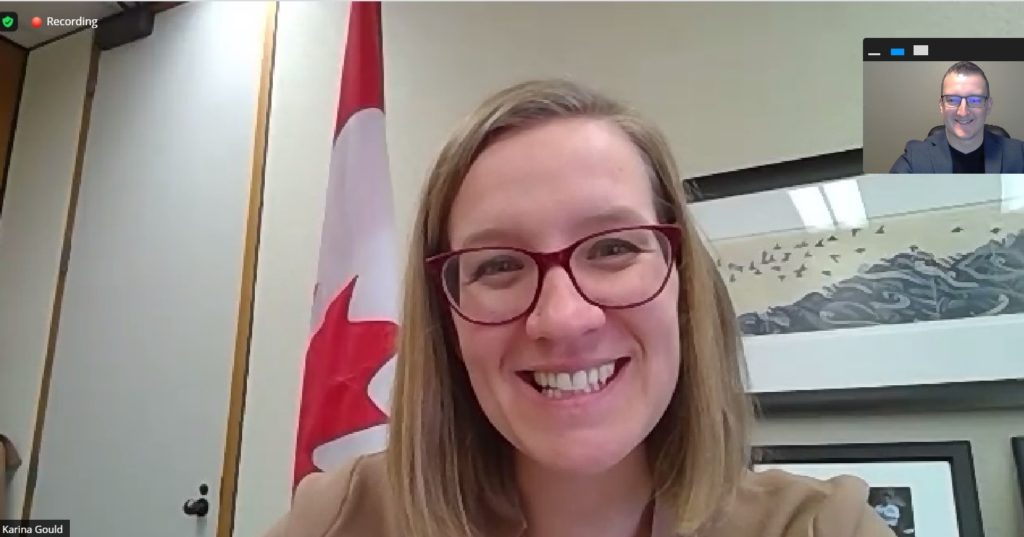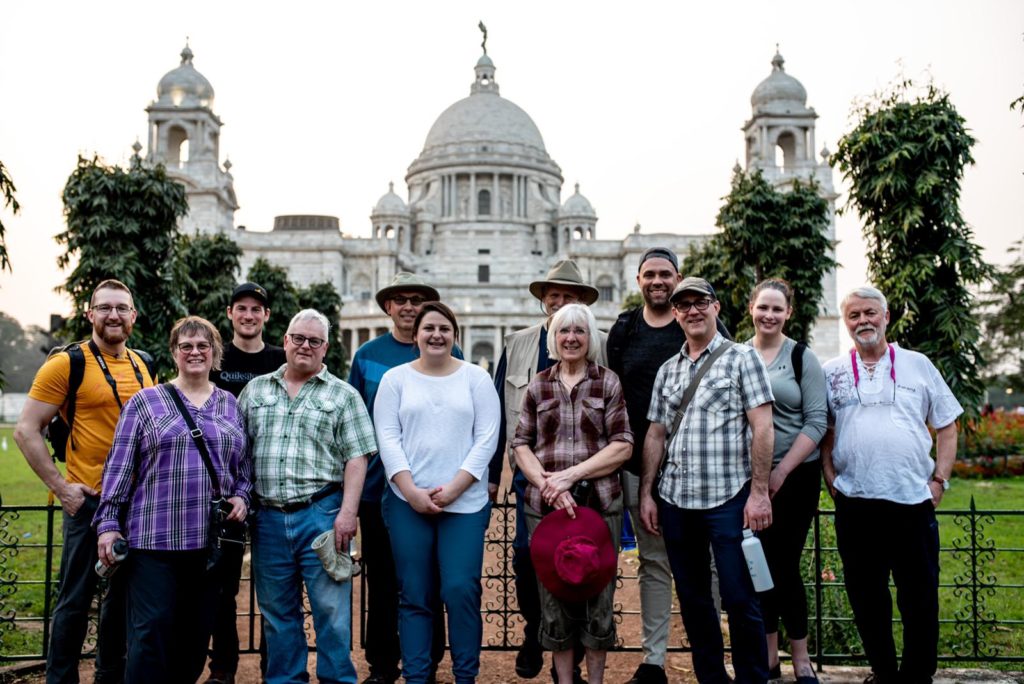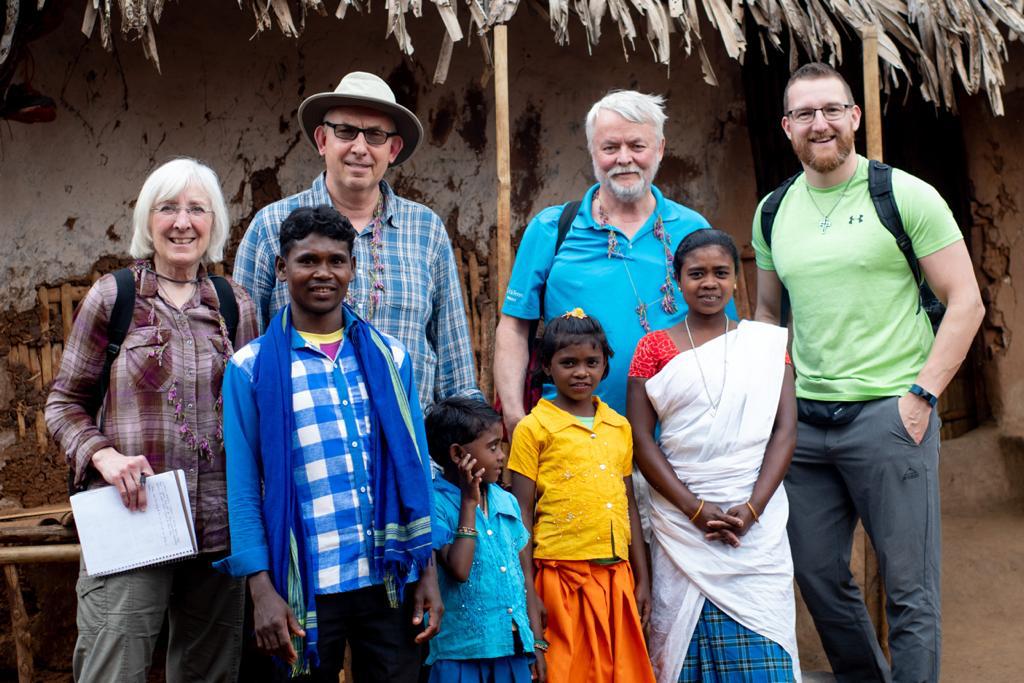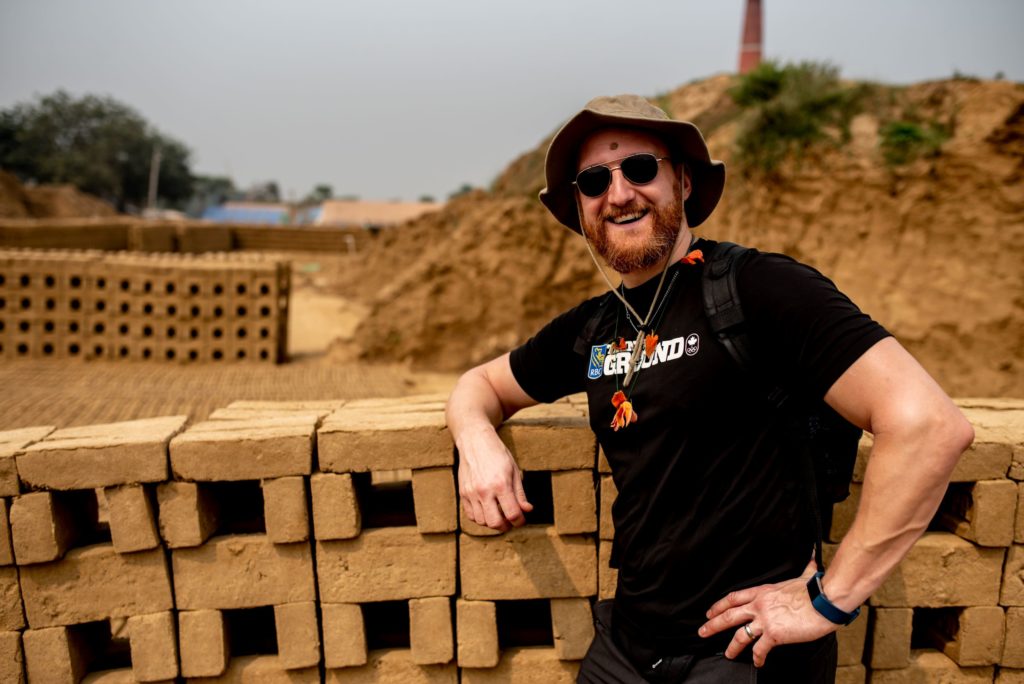Travis Rintoul manages a team of agricultural bankers across southern Manitoba. He is also a growing project member from Manitoba who traveled to India in March 2020 on a Foodgrains Bank study tour. The following are some of his reflections from the tour, as well as his reflections on what it meant to him to be a voice for the people he met there when he came back to Canada.
Being a part of this year’s Hunger on the Hill campaign really changed my view of what it means to be an advocate. I was really encouraged by the fact that every member of Parliament that we met with actually welcomed hearing from us, because they know that these are simply everyday Canadians who are passionate about issues that are important to them. While this year’s campaign was different from previous years, having to be held via Zoom instead of in-person, it was certainly no less important.

Zoom call with Minister of International Development, Karina Gould.
Covid-19 has only exacerbated the problem of world hunger, making it very timely that the Canadian Foodgrains Bank lead discussions on how Canada can help the world’s most vulnerable citizens. Fortunately, this is already a topic that is top of mind to many of our MP’s, as well as Minister of International Development, Karina Gould. In today’s very polarized political environment, I was very pleased to see bipartisan support for addressing issues of world hunger. It seemed that regardless of what side of the aisle these MP’s were on, helping to feed the hungry was important to them all. And for good reason; after watching world hunger statistics drop over the past decade, the Foodgrains Bank is now seeing these numbers rise again. As a recent learning tour participant, I and my fellow advocates were able to bring first-hand, real- world experience to our elected officials, giving them a sense of the realities behind these world hunger statistics. We were able to discuss the families, the women farmers, and the children, who experience the struggles of world hunger, every single day. While there is still so much more work to be done, I left these sessions with a renewed sense of optimism for the future ahead. Canada is a country that cares, and regardless of our political affiliations, the work that the Foodgrains Bank is doing is something that all Canadians can rally behind!

Learning Tour group pose for a photo outside Victoria Memorial in Kolkata, India.
India Learning Tour – 2020
“For I was hungry, and you gave Me something to eat, I was thirsty, and you game Me something to drink; I was a stranger, and you invited Me in” – Matthew 25:35
In a year of lockdowns and pandemic protocols, it’s incredible to me to look back and realize that it was this same year that I was able to travel to the other side of the world with a group of Canadian Foodgrains Bank volunteers to see the first-hand account of some of the world’s most vulnerable citizens. We left in mid- February, when Covid-19 was already a major topic of discussion in the news media, but when the disease was still then focused in China. We never imagined the extent that this pandemic would later disrupt the globe. We changed our stopover flight from Hong Kong to Abu Dhabi, departing completely in the other direction, but barely adding even an hour to our overall travel time; As I said, the other side of the world…
The sights, the sounds, the colours, and the smells that greeted us in Kolkata were absolutely remarkable (both good and bad) and it was an experience I will not soon forget. But aside from all of the touristy wonders of this small slice of India, it was actually the people who really impacted me the most. From our wonderful guides like Professor Dipak, to the volunteers at MCC India and their local partner EFFICOR, to the staff and cooks at the Baptist Missionary guest house, to all of the smiling faces in the remote farming villages, everyone was so incredibly loving and welcoming to us Canadians. We were a spectacle, that is to be sure. Some of the remote areas we visited required us to travel by four-wheel drive up breath-taking landscape vistas and red-dirt roads (almost reminiscent of Canada’s own Prince Edward Island). These remote villages rarely see white-folk at all, and so the fact that several of our tour participants also happened to be well-over 6ft tall didn’t help us to blend either.

A visit to a village where community members are being trained in sustainable agriculture in Pakur, India.
A warm welcome, despite our differences
Still, I think there was a lot more in common than we had differences. For starters, after being mindful of cultural norms and being respectful of not all taking our phone cameras out at the same time, the first group of villagers greeted us to a wonderful song and dance as we entered their village. Drums, clapping, singing, as well as what seemed like a hundred smart phone cameras all pointed at us! While their food supply chains may be easily disrupted, these villagers’ desire to be connected to the world certainly is not and as an attestation to that, my face is now in dozens of selfies on each of their respective social media accounts.
Exploring the link between food security and education
While I could share many more amazing stories of our tour, ironically, it was actually one of the non-Foodgrains Bank funded projects we visited that highlighted the importance of the Foodgrains Bank’s work to me in the most meaningful way. It should be no surprise to anyone that education is the key to breaking through the cycle of poverty. This is apparent in our own country, but also in the hopes of a young 9 year old girl in Jharkhand province named Biji (pictured with her family below), whose dream is to one day become a medical doctor. From inside their mud hut home, Biji’s parents were beaming as they told us their dream is for their children to be educated. They know that a grade-school education is the stepping stone that will elevate their family out of poverty. It’s not unlike the sentiment shared by many Canadian parents, including my wife and I; for our children to have a better life.

Biji and her family with some of the tour participants.
However, when it comes to educating young people, a harsh reality facing many farm families in east-India is that this goal takes a back-seat to food security. While in West Bengal, I was told that India is home to over one hundred thousand brick fields, each producing 1-1.5 million bricks per year. I’ve since Google searched that figure to verify that it wasn’t being exaggerated, but to be honest, at the time I never questioned it. There is virtually no stick-frame construction in this part of India and every building is made of bricks. In fact, one village we visited seemed to be strangely familiar to me as I recalled some of the creations my kids have shown me in their Minecraft worlds. Throughout our tour, we often came across piles of bricks on the side of the road, placed there by the crews of Indian lads we passed on the roadways, who hung off the side of crude flat-deck trailers pulled by 1980’s-era tractors, in preparation for the next home or structure to be built nearby.
When an Indian farmer is not able to produce enough crops in a year to support his or her family, the brick field is often where they go.

Travis Rintoul visits a nearby brick field.
As you can imagine, the agricultural areas of India and the areas conducive for brick manufacturing are not typically one in the same. Thus, a move to work in a brick field is often an endeavour taken by the whole family. For the 6-8 months of brick production, these families live in crude brick houses with tin roofs. Goats, chickens, and children can be seen wandering throughout these industrial sites, with little to no supervision. And education?… forget about that. While the other children of the village continue to progress in their grade- school learning, the children of these families living in the brick fields have little to no hope of making up the time lost from being away.
Sustainable agriculture and a hand-up out of poverty
And that, right there, is the epiphany that I came to on this trip. That is, education is only important when food security isn’t. Ultimately, it’s food security that is going to be the enabler for these families to break through the cycle of poverty and provide an education to their children. If children like Biji have any hope of growing up to become a doctor, then we need to do all we can to ensure her family, and others like hers, are able to sustain themselves and their farms.
People in poverty aren’t looking for a hand-out, but rather a hand-up. The Foodgrains Bank projects that we observed are investments made in the stability of these regions. The Foodgrains Bank and their in-country partners like EFICOR and MCC India are working on legacy projects that will have a long lasting impact. This includes things like water wells used by the entire village; teaching of crop rotation practices; general hygiene to prevent the spread of disease and schools for children.
My tour to India was an incredible experience, and I am honoured to have been given the opportunity to meet so many incredible people. Hopefully one day, when travel restrictions are behind us, I will go back. In the meantime, I am greatly encouraged by all of the incredible work being done by the Foodgrains Bank and its partners on the ground in India and around the world!


